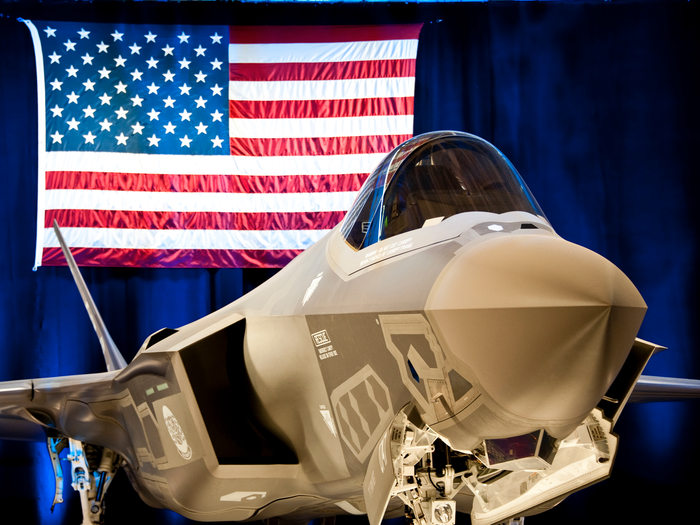
Global tensions are rising and the arms industry is booming. Prime Minister Mark Carney has committed Canada to an unprecedented military buildup. And he claims it will create jobs and catalyze industry. In July he pledged to lift defence spending to two per cent of GDP this year and to five per cent by 2035, saying:
“As our Allies seek to increase their military readiness, they will buy more equipment and technology made in Canada by Canadian workers, in shipyards, in labs, and shop floors right across our country.”
Industry Minister Mélanie Joly echoed the promise of “tens of thousands of jobs” and a forthcoming “defence industrial strategy.” Military production is supposed to rescue the economy, which is floundering under the pressures of the trade war and declining productivity.
A gift to U.S. arms companies
But there are a few problems with this. For starters, if arms expenditure is to grow the Canadian economy, the arms must be built in Canada. But roughly three-quarters of Canada’s major defence purchases are from U.S. companies. For example, the following purchases are all made with U.S. companies:
- $27.7 billion F-35 fighter jet deal
- $220 million for light tactical vehicles
- $5 billion for HIMARS artillery
- $10 billion for P-8A patrol planes
- $1.8 billion for naval computer systems
Carney has said that Canada is “too reliant on the United States.” He wants to either shift to buying from other allies or to build more in Canada.
NATO demands that Canada rearm and modernize, and do it fast. But Canada has no ability to produce the advanced weaponry required for this—like stealth jets, next-generation submarines, and advanced radar. And it is a near impossibility that Canada can develop its own military industries capable of doing so.
For example, developing a modern fighter jet took the U.S. more than a decade and over US $50 billion in research and development. Tiny Canada, failing to even launch an electric-vehicle industry, cannot replicate that. Besides being a small economy, Canada is decades behind in the necessary industrial base and technology.
Unable to build these things in Canada, Carney’s new $60 billion contract for submarines is going to either a German or South Korean company. Similarly, even though the F-35 contract is being reviewed, if it’s cancelled, it will just go to a European country instead.
One way or another, this money is sent into a black hole, and won’t stimulate the Canadian economy.
‘Made in Canada’ militarism
Then there’s the Canadian contracts. Carney has ordered two icebreakers for $9.7 billion and three destroyers for $22 billion from Canadian shipbuilders.
This does little to develop the arms industry. These contracts merely maintain existing capacity. And there is little prospect that this will grow the shipbuilding industry beyond what government contracts demand.
Precedent shows that these new ship contracts will do little for the economy and at great cost. Ottawa spent over $21 billion between 2012 and 2022 on the National Shipbuilding Strategy (NSS), building new ships for the Navy. Government estimates say this supported about 20,000 jobs a year and added only $2.3 billion annually to GDP—roughly 0.1 percent of national output.
This spending is highly inefficient. A study from Brown University found that both healthcare and education spending yield twice as many jobs per dollar, compared to military spending.
Compare this to the government’s approach to Canada Post. Its Industrial Inquiry Commission said that “Canada Post is facing an existential crisis: It is effectively insolvent, or bankrupt.” The government right now is cutting Canada Post, putting 55,000 good union jobs at risk. Yet Canada Post lost $841 million last year, or around $15,000 per job. Meanwhile, the NSS cost about $105,000 per job and produced nothing socially useful.
The Canadian arms industry
The broader problem is that Canada’s tiny “defence” industry cannot be built into a serious pillar of the economy.
The arms industry accounts for around $10 billion in economic activity. That’s 0.4 per cent of the GDP. It also maintains 81,200 jobs. Many of these workers work for the Canadian branch of a foreign company—like Lockheed Martin Canada.
It is a fantasy to believe that this small, technologically narrow industry could grow enough to be a serious economic engine. For this to happen, Canadian weapons would have to be an attractive product for other countries. That would require massive investment in research and development and hugely upscaling production.
For a capital-intensive industry like armaments, hundreds of billions of dollars of investment would be needed, not just from the government but from private investors. But the economy is in a miserable state and investment is fleeing the country—$16.8 billion in foreign investment and $26.8 billion in Canadian capital flowed out of Canada in the 2nd quarter of this year alone.
The government would need to invest hundreds of billions to develop a home grown military industrial complex and even if they did, the small Canadian market would not suffice to maintain those industries. By the time the Canadian government would be capable of developing local production for military equipment, it is doubtful that they would be able to compete with the more well established military producers.
But even if Canada did become a big global arms producer, this is no stable basis for an economy. Arms industries produce no value for the real economy and this is essentially the same as throwing money down a giant pit. While this sort of thing could have an effect on the economy in the short term, it cannot form the basis for any real economic strength, even in the best conditions.
But Canada is not in the best situation—very much the opposite. This is why government spending on arms ends up being sent abroad or spent in a limited, inefficient way in Canada.
A nightmare for workers
The result is that military spending—far from turning the Canadian arms industry into a juggernaut—is a massive drain on the economy. Instead of being used to produce things in Canada, raising the productivity of labour and increasing the consumer market, the money is being used to subsidize the arms industries in other countries.
And the money has to come from somewhere. Carney’s deficit—before military spending hikes are accounted for—is the highest in history. In order to do this, is he planning 15 per cent cuts to departments across the board.
Hitting five per cent of GDP military spending means spending $112.5 billion per year—more than the federal healthcare and education budgets combined. To pay for this, biblical cuts to public services will be required.
All working Canadians will be made to pay through austerity. Meanwhile, foreign arms companies, along with Canadian billionaires like New Brunswick’s infamous Irving family—whose company is producing one of the destroyers—will cash the cheques.
A very small number of workers will get jobs but this will be offset by tens of thousands of jobs lost in the public sector.
In an epoch of rising imperialist tensions, capitalism demands more and more money go to weapons of death and destruction. Capitalism today offers only war, austerity, and misery for us. It must be overthrown and replaced with a planned economy controlled democratically by the workers.
Then these workers could be put to work fixing society’s real problems—doing jobs like building housing and public transit, fighting wildfires, developing better green technology. Like this, we could build a better future free of war, poverty, and all the evils of capitalism.

